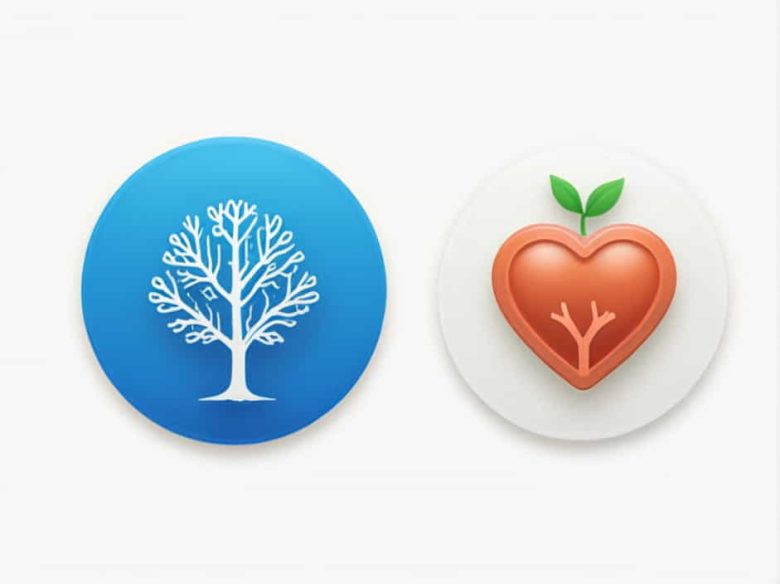Both plants and animals have specialized transport systems that allow the movement of essential substances. In plants the xylem and phloem distribute water minerals and nutrients while in animals the circulatory system ensures the delivery of oxygen nutrients and waste removal.
Although these systems serve similar purposes they function in very different ways. In this topic we will compare xylem and phloem with the human circulatory system exploring their structures functions and key differences.
1. What Are Xylem and Phloem?
Plants rely on two main transport tissues:
- Xylem – Carries water and minerals from the roots to the rest of the plant.
- Phloem – Transports food (sugars) produced during photosynthesis to different parts of the plant.
Together these tissues form the vascular system of plants similar to how the circulatory system works in animals.
a) Structure of Xylem
The xylem consists of dead hollow cells that form long tubes. These tubes allow water to move upward through capillary action and transpiration pull. The cell walls of xylem vessels are strengthened with lignin making them rigid and supportive.
b) Structure of Phloem
Phloem tissue is made up of living cells that transport sugars (mainly sucrose) throughout the plant. It consists of:
- Sieve tube elements – Cylindrical cells that form a continuous tube for sugar transport.
- Companion cells – Help sieve tube elements by providing energy for active transport.
2. What Is the Circulatory System?
The human circulatory system is responsible for transporting oxygen nutrients hormones and waste throughout the body. It consists of:
- The heart – Pumps blood through the body.
- Blood vessels – Arteries veins and capillaries that carry blood.
- Blood – The transport medium containing red and white blood cells platelets and plasma.
a) Structure of the Circulatory System
- Arteries – Carry oxygenated blood away from the heart.
- Veins – Bring deoxygenated blood back to the heart.
- Capillaries – Tiny vessels where gas and nutrient exchange occurs.
b) How the Circulatory System Works
The heart pumps blood through two main circuits:
- Pulmonary circulation – Blood travels between the heart and lungs to receive oxygen.
- Systemic circulation – Blood carries oxygen and nutrients to tissues and organs.
3. Similarities Between Xylem Phloem and the Circulatory System
Although plants and animals are vastly different their transport systems share some similarities:
a) Transport of Essential Substances
- Xylem and phloem transport water minerals and sugars.
- The circulatory system moves oxygen nutrients and waste.
b) Network of Tubes
- Xylem and phloem form a network of vascular tissues.
- The circulatory system consists of blood vessels.
c) Continuous Movement
- Water and nutrients in plants move continuously through the xylem and phloem.
- Blood circulates constantly in the human circulatory system.
d) Role in Survival
- Plants rely on xylem and phloem for growth and survival.
- Animals depend on the circulatory system to sustain life.
4. Differences Between Xylem Phloem and the Circulatory System
Despite their similarities these transport systems have fundamental differences:
| Feature | Xylem | Phloem | Circulatory System |
|---|---|---|---|
| Type of Transport | Water and minerals | Sugars and nutrients | Oxygen nutrients and waste |
| Direction of Flow | One-way (roots to leaves) | Two-way (leaves to other parts) | Continuous circulation |
| Cells | Dead cells | Living cells | Living cells |
| Movement Mechanism | Passive (transpiration pull capillary action) | Active (requires energy) | Active (heart pumping) |
| Transport Medium | Water | Sugar (sucrose) | Blood |
| Speed of Transport | Slow | Moderate | Fast |
a) One-Way vs. Two-Way Transport
- Xylem transports water only upward from the roots.
- Phloem transports sugars in both directions.
- The circulatory system continuously moves blood throughout the body.
b) Passive vs. Active Transport
- Xylem relies on natural forces like transpiration pull and capillary action.
- Phloem requires energy (ATP) to move sugars.
- The circulatory system depends on the heart to actively pump blood.
c) Speed of Transport
- Xylem and phloem transport substances relatively slowly.
- The circulatory system moves blood quickly to meet the body’s demands.
5. Why Are These Transport Systems Important?
a) Importance of Xylem and Phloem in Plants
- Xylem supplies water needed for photosynthesis.
- Phloem distributes food ensuring growth and energy storage.
- Without them plants would not survive.
b) Importance of the Circulatory System in Animals
- Delivers oxygen and nutrients to cells.
- Removes carbon dioxide and waste products.
- Protects the body through immune cells and blood clotting.
6. How to Keep These Systems Healthy?
a) Keeping Xylem and Phloem Healthy
- Provide adequate water and nutrients to plants.
- Protect plants from pests and diseases that damage vascular tissues.
- Ensure good soil quality for optimal root absorption.
b) Keeping the Circulatory System Healthy
- Eat a balanced diet rich in fruits vegetables and whole grains.
- Exercise regularly to strengthen the heart and blood vessels.
- Avoid smoking and excessive alcohol consumption.
- Stay hydrated to maintain proper blood flow.
Both xylem and phloem in plants and the circulatory system in animals play a crucial role in sustaining life. While they share similarities such as transporting essential substances they also have distinct differences in structure function and movement mechanisms.
Understanding these transport systems highlights how nature has developed efficient ways to ensure survival whether in a towering tree or a living organism. By taking care of these systems we ensure the health and well-being of plants animals and humans alike.



